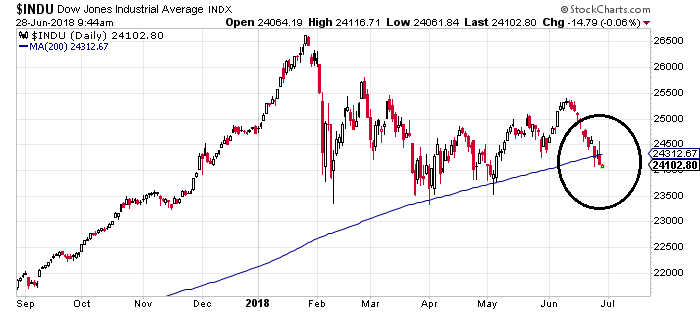One Technical Analysis Indicator Calls for Headwinds on the Stock Market
Mark my words: the stock market could be setting up to disappoint investors. An outright crash could be looming.
Why have such a dire outlook on the stock market? Because all the stars are lining up perfectly for a sell-off. Complacent investors could be setting up their portfolios for major disappointment.
Look at the chart below of the Dow Jones Industrial Average and pay close attention to the blue line. It represents the 200-day moving average of the Dow.
Consider the 200-day moving average as a long-term trend indicator.
If the stock market is trading above this moving average, it means the trend is pointing upward. An investor who is long (buys stocks) could make money.
If the stock market trades below the moving average, it means the trend is pointing downward, bearish sentiment is prevailing, and the stock market will likely drag lower. An investor who shorts (sells stocks), could make money.

Chart courtesy of StockCharts.com
You see, just recently, the Dow Jones Industrial Average broke below its 200-day moving average for the first time since 2016 and closed below that level.
Ask any technical analyst and they will tell you that this is really bad news. It says that the trend on the stock market has turned in favor of the bears and that losses could follow.
Also, notice something interesting on the above chart? In April and May, the Dow was able to recover after it hit the 200-day moving average. Recently, it wasn’t able to do that again. At its core, this says that buyers aren’t there anymore at this moving average. That is a bearish sign.
Economic Data Could Cause Investors to Sell
Beyond this, look at the U.S. economy.
Investors cheered and bought stocks, thinking that there’s growth in the U.S. economy. As a result, the stock market jumped higher.
What do you think investors will do if they find that the U.S. economy isn’t growing as fast as they expected?
Consider this: according to the Bureau of Economic Analysis (BEA), in the first quarter of 2018, the U.S. economy grew at an annual pace of just two percent. (Source: “National Income and Product Accounts Gross Domestic Product: First Quarter 2018 (Third Estimate) Corporate Profits: First Quarter 2018 (Revised Estimate),” Bureau of Economic Analysis, June 28, 2018.)
If we assume that this is the final number, it would be well below what the Federal Reserve expected. This rate is also much slower than what organizations like the International Monetary Fund (IMF) expected the U.S. economy to do.
So, if investors had wrong expectations of the economy, they could be looking to sell. This could be bad news for the stock market as well.
After the Summer, Caution Must Be Used
Dear reader, something bad is brewing.
For the stock market to go higher, you need bullish investor sentiment and solid economic data. We don’t have any of that as it stands. This shouldn’t be taken lightly.
I will end with this: in the summer, the stock markets may not do much. Summer is generally a calm period. Come September and October, it’s important that investors remain cautious. This is when volume comes back and we could see wild swings on the key stock indices.
In the meantime, it may not be a bad idea for investors to assess their portfolios closely and set stop-losses in case there’s a sell-off.






